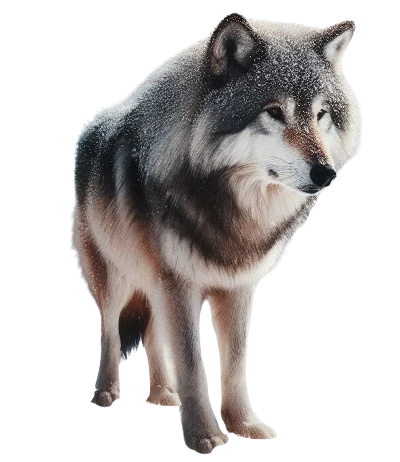
The Gray Wolf (Canis lupus) is an iconic species among canids, renowned for its social behavior, intelligence, and adaptability to a wide variety of environments. Found throughout the Northern Hemisphere, it plays a critical role in maintaining ecosystem balance.
The Gray Wolf is a large canid, standing between 60 and 90 cm at the shoulder and weighing 25 to 50 kg depending on the region. Its lean and muscular body is perfectly adapted for hunting. Its dense coat, often gray with shades of brown, white, and black, provides protection against extreme weather conditions. Its broad head with erect ears and amber eyes reflects remarkable intelligence.
The Gray Wolf (Canis lupus) belongs to the Canidae family, which also includes domestic dogs, foxes, and coyotes.
The Gray Wolf is also the direct ancestor of domestic dogs (Canis lupus familiaris), a result of thousands of years of domestication. Today, numerous subspecies of gray wolves exist, adapted to the diverse habitats they occupy worldwide.
Gray wolves inhabit a variety of regions, from boreal forests to mountains, grasslands, and even deserts. Their range extends from North America to Eurasia. They require vast territories for hunting and maintaining their complex social structures.
Gray wolves live in packs organized around a dominant pair known as the "alpha." Each pack, typically consisting of 5 to 12 members, functions as a cohesive social unit. These predators are highly communicative, using a wide range of vocalizations, postures, and scent signals to interact. Their cooperative hunting strategies allow them to take down prey much larger than themselves, such as deer or bison.
An opportunistic carnivore, the Gray Wolf primarily feeds on large herbivores like deer, elk, and wild boar. However, it also eats smaller mammals, birds, or carrion when prey is scarce. This varied diet demonstrates its ability to adapt to changing environments.
Although the Gray Wolf has faced widespread persecution from humans, conservation efforts have led to its resurgence in areas where it had been eradicated, such as Western Europe. However, it remains threatened by habitat fragmentation and conflicts with human activities. Raising public awareness of its ecological role is vital to ensuring its survival.
The Gray Wolf belongs to the genus Canis, which also includes the Coyote (Canis latrans), the Golden Jackal (Canis aureus), and the Dingo (Canis lupus dingo). These species share common characteristics, notably their social structure and hunting behaviors.
Observing gray wolves in their natural habitat can be a fascinating experience, but it requires respect and caution. Here are some tips to make the most of this activity while preserving their well-being and environment.
By following these tips, you will help preserve wolves and their habitat while enjoying an unforgettable adventure in nature.